Yue Liu
On the Impact of Phase Errors in Phase-Dependent Amplitudes of Near-Field RISs
Dec 28, 2025Abstract:This paper investigates mutual coupling between phase-dependent amplitudes (PDAs) and designed phase shifts within pixels of near-field (NF) reconfigurable intelligent surfaces (RISs) in the presence of phase errors (PEs). In contrast to existing research that treats phase shifts with errors (PSEs) and the PDAs separately, we introduce a remaining power (RP) metric to quantify the proportion of power preserved in the signals reflected by the RIS, and we prove its asymptotic convergence to theoretical values by leveraging extended Glivenko-Cantelli theorem. Then, the RP of signals passing through RIS pixels is jointly examined under combined phase and amplitude uncertainties. In addition, we propose four pixel reflection models to capture practical conditions, and we derive approximate polynomial upper bounds for the RP with error terms by applying Taylor expansion. Furthermore, based on Friis transmission formula and projected aperture, we propose a general NF channel model that incorporates the coupling between the PSEs and the PDAs. By using Cauchy-Bunyakovsky-Schwarz inequality and Riemann sums, we derive a closed-form upper bound on spectral efficiency, and the bound becomes tighter as the pixel area decreases. We reveal that as the RIS phase shifts approach the ends of their range, the RP under independent and identically distributed PEs is smaller than that under fully correlated PEs, whereas this relationship reverses when the phase shifts are near the middle of their range. Neglecting the PEs in the PDAs leads to an overestimation of the RIS performance gain, explaining the discrepancies between theoretical and measured results.
Flowing from Reasoning to Motion: Learning 3D Hand Trajectory Prediction from Egocentric Human Interaction Videos
Dec 18, 2025Abstract:Prior works on 3D hand trajectory prediction are constrained by datasets that decouple motion from semantic supervision and by models that weakly link reasoning and action. To address these, we first present the EgoMAN dataset, a large-scale egocentric dataset for interaction stage-aware 3D hand trajectory prediction with 219K 6DoF trajectories and 3M structured QA pairs for semantic, spatial, and motion reasoning. We then introduce the EgoMAN model, a reasoning-to-motion framework that links vision-language reasoning and motion generation via a trajectory-token interface. Trained progressively to align reasoning with motion dynamics, our approach yields accurate and stage-aware trajectories with generalization across real-world scenes.
QSMnet-INR: Single-Orientation Quantitative Susceptibility Mapping via Implicit Neural Representation in k-Space
Dec 10, 2025Abstract:Quantitative Susceptibility Mapping (QSM) quantifies tissue magnetic susceptibility from magnetic-resonance phase data and plays a crucial role in brain microstructure imaging, iron-deposition assessment, and neurological-disease research. However, single-orientation QSM inversion remains highly ill-posed because the dipole kernel exhibits a cone-null region in the Fourier domain, leading to streaking artifacts and structural loss. To overcome this limitation, we propose QSMnet-INR, a deep, physics-informed framework that integrates an Implicit Neural Representation (INR) into the k-space domain. The INR module continuously models multi-directional dipole responses and explicitly completes the cone-null region, while a frequency-domain residual-weighted Dipole Loss enforces physical consistency. The overall network combines a 3D U-Net-based QSMnet backbone with the INR module through alternating optimization for end-to-end joint training. Experiments on the 2016 QSM Reconstruction Challenge, a multi-orientation GRE dataset, and both in-house and public single-orientation clinical data demonstrate that QSMnet-INR consistently outperforms conventional and recent deep-learning approaches across multiple quantitative metrics. The proposed framework shows notable advantages in structural recovery within cone-null regions and in artifact suppression. Ablation studies further confirm the complementary contributions of the INR module and Dipole Loss to detail preservation and physical stability. Overall, QSMnet-INR effectively alleviates the ill-posedness of single-orientation QSM without requiring multi-orientation acquisition, achieving high accuracy, robustness, and strong cross-scenario generalization-highlighting its potential for clinical translation.
RAC-DMVC: Reliability-Aware Contrastive Deep Multi-View Clustering under Multi-Source Noise
Nov 17, 2025



Abstract:Multi-view clustering (MVC), which aims to separate the multi-view data into distinct clusters in an unsupervised manner, is a fundamental yet challenging task. To enhance its applicability in real-world scenarios, this paper addresses a more challenging task: MVC under multi-source noises, including missing noise and observation noise. To this end, we propose a novel framework, Reliability-Aware Contrastive Deep Multi-View Clustering (RAC-DMVC), which constructs a reliability graph to guide robust representation learning under noisy environments. Specifically, to address observation noise, we introduce a cross-view reconstruction to enhances robustness at the data level, and a reliability-aware noise contrastive learning to mitigates bias in positive and negative pairs selection caused by noisy representations. To handle missing noise, we design a dual-attention imputation to capture shared information across views while preserving view-specific features. In addition, a self-supervised cluster distillation module further refines the learned representations and improves the clustering performance. Extensive experiments on five benchmark datasets demonstrate that RAC-DMVC outperforms SOTA methods on multiple evaluation metrics and maintains excellent performance under varying ratios of noise.
Enabling Wireless Power Transfer (WPT) in Pinching Antenna Systems (PASS)
Nov 14, 2025Abstract:A novel pinching antenna system (PASS) enabled wireless power transfer (WPT) framework is proposed, where energy harvesting receivers (EHRs) and information decoding receivers (IDRs) coexist. By activating pinching antennas (PAs) near both receivers and flexibly adjusting PAs' power radiation ratios, both energy harvesting efficiency and communication quality can be enhanced. A bi-level optimization problem is formulated to overcome the strong coupling between optimization variables. The upper level jointly optimizes transmit beamforming, PA positions, and feasible interval of power radiation ratios for power conversion efficiency (PCE) maximization under rate requirements, while the lower level refines power radiation ratio for the sum rate maximization. Efficient solutions are developed for both two-user and multi-user scenarios. 1) For the two-user case, where an EHR and an IDR coexist, the alternating optimization (AO)-based and weighted minimum mean square error (WMMSE)-based algorithms are developed to achieve the stationary solutions of transmit beamforming, PA positions, and power radiation ratios. 2) For the multi-user case, a quadratic transform-Lagrangian dual transform (QT-LDT) algorithm is proposed to iteratively update PCE and sum rate by optimizing PA positions and power radiation ratios individually. Closed-form solutions are derived for both maximization problems. Numerical simulation results demonstrate that the proposed PASS-WPT framework significantly outperforms conventional MIMO and the baseline PASS with fixed power radiation, which demonstrates that: i) Compared to the conventional MIMO and baseline PASS, the proposed PASS-WPT framework achieves 81.45% and 43.19% improvements in PCE of EHRs, and ii) also increases the sum rate by 77.81% and 31.91% for IDRs.
GPR: Towards a Generative Pre-trained One-Model Paradigm for Large-Scale Advertising Recommendation
Nov 13, 2025



Abstract:As an intelligent infrastructure connecting users with commercial content, advertising recommendation systems play a central role in information flow and value creation within the digital economy. However, existing multi-stage advertising recommendation systems suffer from objective misalignment and error propagation, making it difficult to achieve global optimality, while unified generative recommendation models still struggle to meet the demands of practical industrial applications. To address these issues, we propose GPR (Generative Pre-trained Recommender), the first one-model framework that redefines advertising recommendation as an end-to-end generative task, replacing the traditional cascading paradigm with a unified generative approach. To realize GPR, we introduce three key innovations spanning unified representation, network architecture, and training strategy. First, we design a unified input schema and tokenization method tailored to advertising scenarios, mapping both ads and organic content into a shared multi-level semantic ID space, thereby enhancing semantic alignment and modeling consistency across heterogeneous data. Second, we develop the Heterogeneous Hierarchical Decoder (HHD), a dual-decoder architecture that decouples user intent modeling from ad generation, achieving a balance between training efficiency and inference flexibility while maintaining strong modeling capacity. Finally, we propose a multi-stage joint training strategy that integrates Multi-Token Prediction (MTP), Value-Aware Fine-Tuning and the Hierarchy Enhanced Policy Optimization (HEPO) algorithm, forming a complete generative recommendation pipeline that unifies interest modeling, value alignment, and policy optimization. GPR has been fully deployed in the Tencent Weixin Channels advertising system, delivering significant improvements in key business metrics including GMV and CTCVR.
CRAG-MM: Multi-modal Multi-turn Comprehensive RAG Benchmark
Oct 30, 2025



Abstract:Wearable devices such as smart glasses are transforming the way people interact with their surroundings, enabling users to seek information regarding entities in their view. Multi-Modal Retrieval-Augmented Generation (MM-RAG) plays a key role in supporting such questions, yet there is still no comprehensive benchmark for this task, especially regarding wearables scenarios. To fill this gap, we present CRAG-MM -- a Comprehensive RAG benchmark for Multi-modal Multi-turn conversations. CRAG-MM contains a diverse set of 6.5K (image, question, answer) triplets and 2K visual-based multi-turn conversations across 13 domains, including 6.2K egocentric images designed to mimic captures from wearable devices. We carefully constructed the questions to reflect real-world scenarios and challenges, including five types of image-quality issues, six question types, varying entity popularity, differing information dynamism, and different conversation turns. We design three tasks: single-source augmentation, multi-source augmentation, and multi-turn conversations -- each paired with an associated retrieval corpus and APIs for both image-KG retrieval and webpage retrieval. Our evaluation shows that straightforward RAG approaches achieve only 32% and 43% truthfulness on CRAG-MM single- and multi-turn QA, respectively, whereas state-of-the-art industry solutions have similar quality (32%/45%), underscoring ample room for improvement. The benchmark has hosted KDD Cup 2025, attracting about 1K participants and 5K submissions, with winning solutions improving baseline performance by 28%, highlighting its early impact on advancing the field.
Stream RAG: Instant and Accurate Spoken Dialogue Systems with Streaming Tool Usage
Oct 02, 2025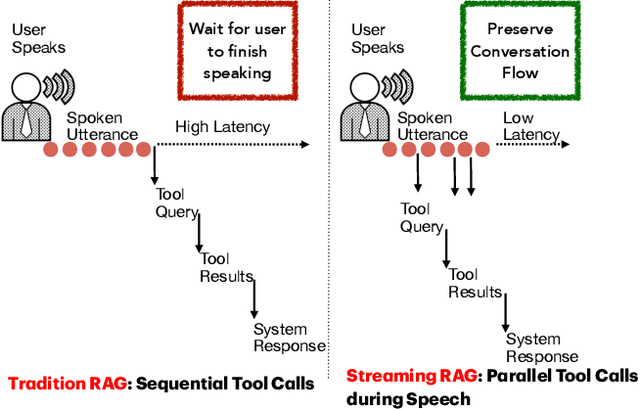
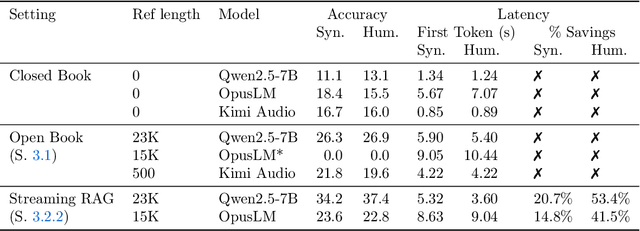
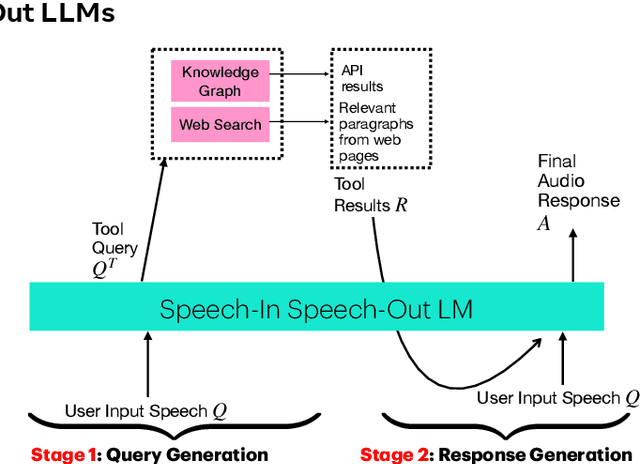
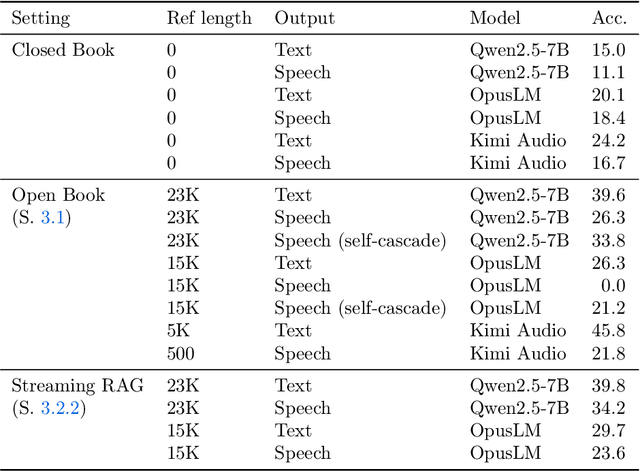
Abstract:End-to-end speech-in speech-out dialogue systems are emerging as a powerful alternative to traditional ASR-LLM-TTS pipelines, generating more natural, expressive responses with significantly lower latency. However, these systems remain prone to hallucinations due to limited factual grounding. While text-based dialogue systems address this challenge by integrating tools such as web search and knowledge graph APIs, we introduce the first approach to extend tool use directly into speech-in speech-out systems. A key challenge is that tool integration substantially increases response latency, disrupting conversational flow. To mitigate this, we propose Streaming Retrieval-Augmented Generation (Streaming RAG), a novel framework that reduces user-perceived latency by predicting tool queries in parallel with user speech, even before the user finishes speaking. Specifically, we develop a post-training pipeline that teaches the model when to issue tool calls during ongoing speech and how to generate spoken summaries that fuse audio queries with retrieved text results, thereby improving both accuracy and responsiveness. To evaluate our approach, we construct AudioCRAG, a benchmark created by converting queries from the publicly available CRAG dataset into speech form. Experimental results demonstrate that our streaming RAG approach increases QA accuracy by up to 200% relative (from 11.1% to 34.2% absolute) and further enhances user experience by reducing tool use latency by 20%. Importantly, our streaming RAG approach is modality-agnostic and can be applied equally to typed input, paving the way for more agentic, real-time AI assistants.
SCRIBES: Web-Scale Script-Based Semi-Structured Data Extraction with Reinforcement Learning
Oct 02, 2025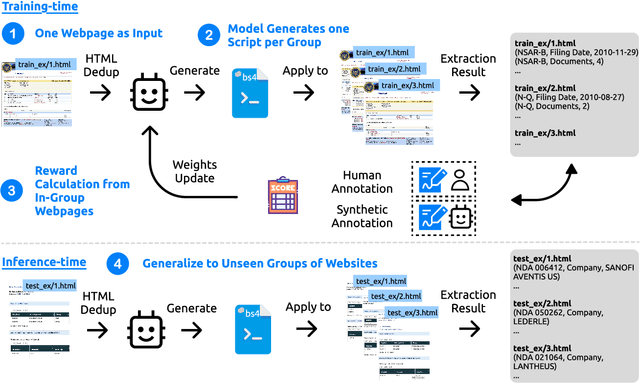
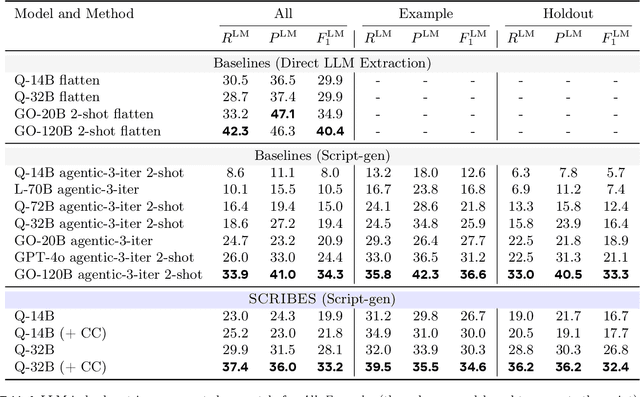


Abstract:Semi-structured content in HTML tables, lists, and infoboxes accounts for a substantial share of factual data on the web, yet the formatting complicates usage, and reliably extracting structured information from them remains challenging. Existing methods either lack generalization or are resource-intensive due to per-page LLM inference. In this paper, we introduce SCRIBES (SCRIpt-Based Semi-Structured Content Extraction at Web-Scale), a novel reinforcement learning framework that leverages layout similarity across webpages within the same site as a reward signal. Instead of processing each page individually, SCRIBES generates reusable extraction scripts that can be applied to groups of structurally similar webpages. Our approach further improves by iteratively training on synthetic annotations from in-the-wild CommonCrawl data. Experiments show that our approach outperforms strong baselines by over 13% in script quality and boosts downstream question answering accuracy by more than 4% for GPT-4o, enabling scalable and resource-efficient web information extraction.
Comprehend and Talk: Text to Speech Synthesis via Dual Language Modeling
Sep 26, 2025Abstract:Existing Large Language Model (LLM) based autoregressive (AR) text-to-speech (TTS) systems, while achieving state-of-the-art quality, still face critical challenges. The foundation of this LLM-based paradigm is the discretization of the continuous speech waveform into a sequence of discrete tokens by neural audio codec. However, single codebook modeling is well suited to text LLMs, but suffers from significant information loss; hierarchical acoustic tokens, typically generated via Residual Vector Quantization (RVQ), often lack explicit semantic structure, placing a heavy learning burden on the model. Furthermore, the autoregressive process is inherently susceptible to error accumulation, which can degrade generation stability. To address these limitations, we propose CaT-TTS, a novel framework for robust and semantically-grounded zero-shot synthesis. First, we introduce S3Codec, a split RVQ codec that injects explicit linguistic features into its primary codebook via semantic distillation from a state-of-the-art ASR model, providing a structured representation that simplifies the learning task. Second, we propose an ``Understand-then-Generate'' dual-Transformer architecture that decouples comprehension from rendering. An initial ``Understanding'' Transformer models the cross-modal relationship between text and the audio's semantic tokens to form a high-level utterance plan. A subsequent ``Generation'' Transformer then executes this plan, autoregressively synthesizing hierarchical acoustic tokens. Finally, to enhance generation stability, we introduce Masked Audio Parallel Inference (MAPI), a nearly parameter-free inference strategy that dynamically guides the decoding process to mitigate local errors.
 Add to Chrome
Add to Chrome Add to Firefox
Add to Firefox Add to Edge
Add to Edge